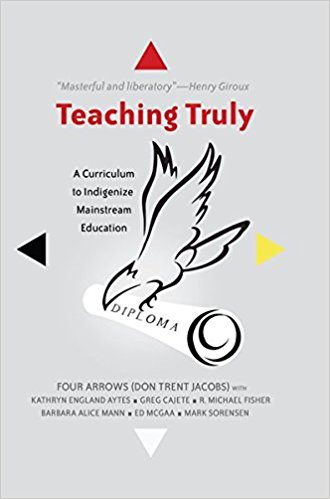Get Teaching Truly by Four Arrows on Amazon
Indigenous Learning Styles
1. Allow for ample observation and imitation rather than verbal instruction.
2. Also allow students to take their time before attempting a task so that the chances for success are higher even on the first effort.
3. Make the group more important than the individual as often as possible in terms of both the learning process and learning goals.
4. Emphasize cooperation versus competition whenever possible.
5. Make learning holistic rather than sequential and analytic. Spend more time in dialogue talking about the big picture associations before looking at details.
6. Use imagery as often as possible. Einstein wrote that “imagination is more powerful than knowledge,” and Indigenous education takes advantage of this fact.
7. Make learning connect to meaningful contexts and real life.
8. Be willing to allow spontaneous learning opportunities to change pre-planned lessons.
9. De-emphasize letter grading and standardized evaluations and use authentic narrative assessments that emphasize whet is actually working best and what needs more work.
From Teaching Truly by Four Arrows (p70-71)
Indigenous Learning Approaches
1. Field experience
2. Cooperative learning
3. Intrinsic motivation
4. Student ownership of subject matter
5. Critical reflection
6. Intuitive work
7. Visualizations and dream work
8. Honoring student pace
9. Using song and music
10. Honoring place
11. Using natural world as teacher
12. Involving community
13. Doing activism and serving others
14. Remembering that everything is connected/related
15. Using humor whenever possible
16. Employing wellness/fitness considerations
17. Using peer teaching
18. Allowing for observation rather than participation
19. Using storytelling prolifically and interactively that is related to the students’ world
20. Being aware of sustainability issues in the class, school and home environment
From Teaching Truly by Four Arrows (p79-80)
Indigenous Approaches to Conflict Resolution
1. Make bringing everyone back into community the main objective.
2. Widen the circle of blame and involvement to include all possible individuals who may have some influence on the problem or the solution.
3. Use ample and appropriate humor throughout the process.
4. Appeal to a universal sense of love and power that connects all participants.
5. Discuss cognitive dissonance in ways that show it is human to react to it.
6. Avoid punishments and instead seek honorable reciprocity.
7. Refer when possible to the non-human kingdoms for metaphors.
From Teaching Truly by Four Arrows (p71)
